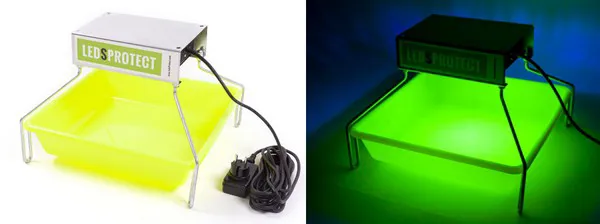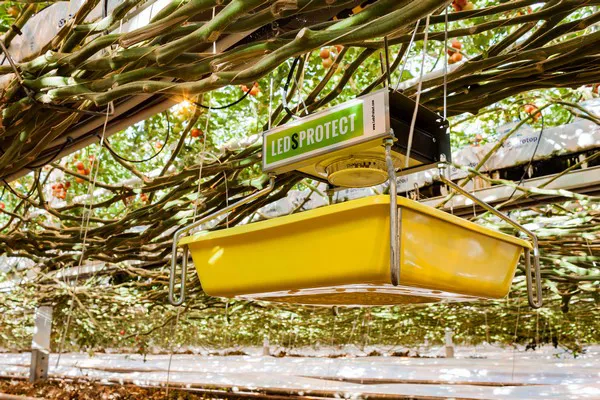Pest insects cause a lot of damage in greenhouses. Growers looking to prevent this can lure the insects away by presenting them with something irresistible, which is exactly what LedsProtect does with their new UV-light trap.
Since the introduction of LedsProtect back in 2015, they have kept on developing and improving. LedsProtect can now be delivered with a fluorescent yellow tray. The lenses and LEDs have also been improved.
“We are one of the three companies in the world that use this special plastic. The light passes through more easily and in the desired wavelength”, says Peter Kerkhof, director and creator of the UV-light trap. “Our electronic engineer Ad van de Wildenberg co-formulated the plastic after discussing with a specialist from a raw material supplier. Because of this, we are now able to use LEDs with a better UV wavelength, and the insects are lured more effectively.”

The latest model UV-light trap by LedsProtect can’t be missed at night.
Fluorescent yellow
The choice in special plastic exemplifies how LedsProtect continues to put time and effort into product development. And growers are taking notice. “We introduced the fluorescent yellow tray last year. A tomato grower bought 60 LP3 traps to combat a Tuta infestation that had gotten out of hand. Within one week, all flying Tuta were caught in the traps. The traps included two prototypes of the fluorescent tray. The difference in catching rates was noticeable, and the grower immediately orders 60 new fluorescent trays.”
A Sempervivum grower used LedsProtect to combat crane flies (daddy longlegs). The fluorescent tray tripled his catch rate to 300 crane flies per night per trap, Peter noted. “The fluorescent tray differentiates us from the rest of the market.”
Scouting
Peter does warn: “LedsProtect is not the solution to the problem, but it helps growers to solve the problem they have.” Even the above-mentioned tomato grower took several other countermeasures to combat the Tuta. Peter also likes to give some advice on the matter. Of course, about the use of his product but also pest insects in general, “Knowing and recognizing the enemy is the first step in combating them.”

Growers in both ornamental and greenhouse vegetable cultivation use the trap
To do this, it is important to know what exactly the grower is dealing with. “Our traps are ideal for scouting. Good pest control starts with knowing what you’re up against. In combating the pests, we advise growers to place nine traps per hectare for good coverage. The water container needs to be cleaned and refilled once a week, which is the moment to take a good look at what has been caught in the traps. The traps actively help in following the pest population.”
At night
The reach of the trap is about fifteen meters. “Moths, at most, can see ten to fifteen meters ahead. Providing more light to make the traps even brighter would not be beneficial, the tests conclude. Nine traps per hectares provide good coverage.”
Growers use the UV-light traps at night. At this moment, pollinators and biological control agents are (almost) never active. “That is why growers don’t catch many pollinators in their traps and very little biological control agents.”
Green shield bugs
For green shield bug (Nezera), the UV-light trap is, as of yet, not a fit solution. It remains a difficult pest to deal with. However, over the past couple of years, Peter did conduct various tests to see if it would be possible to catch the bugs in the future. At the moment, Rob Berkelmans of Dutch organic grower BioVerbeek is conducting tests with lighting from below, through the catching trays, as Peter is aware of. “We hope to know more about this by the end of summer.”
However, for growers with electricity access above the cultivation area, there is a solution. “For instance, tomato growers often only have electricity in their walking paths. We work with a central adaptor in the middle of the paths and a cable to not make outlets everywhere. In a radius of about thirty meters from the adaptor, it is then possible to put the traps without much trouble.” The traps pay for themselves in no time. “The costs of a trap is only a fraction of the damage one out-of-control infestation would cause.”
For more information:
LedsProtect
www.ledsprotect.com
info@ledsprotect.com
Peter Kerkhof
pkerkhof@ledsprotect.com
